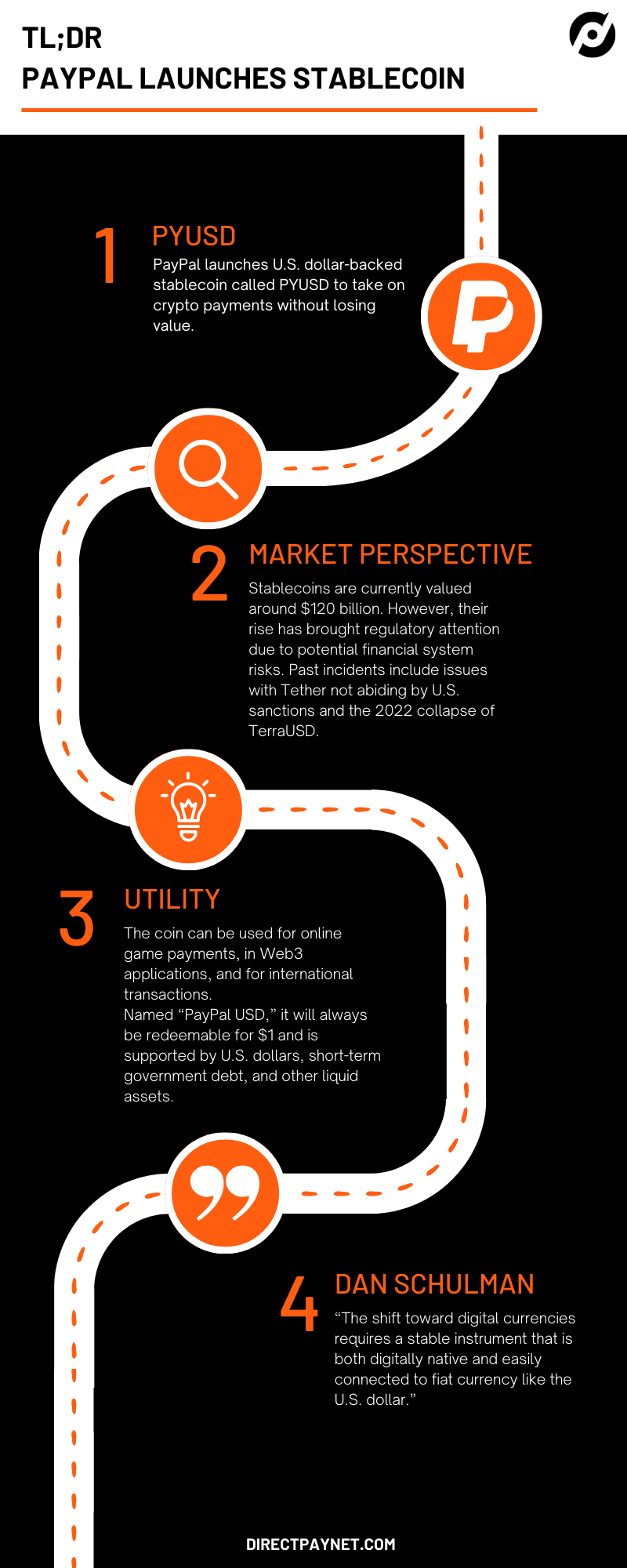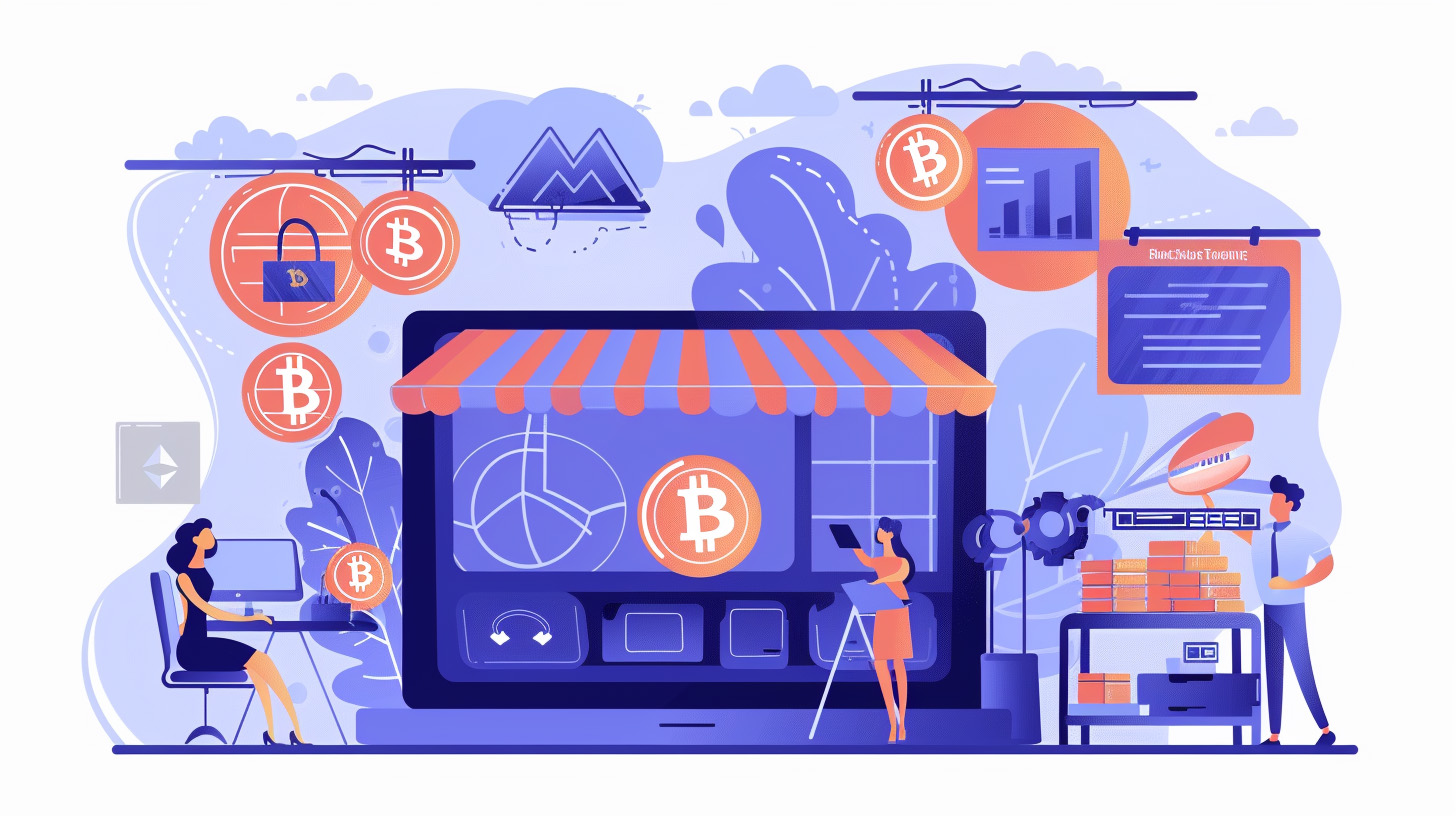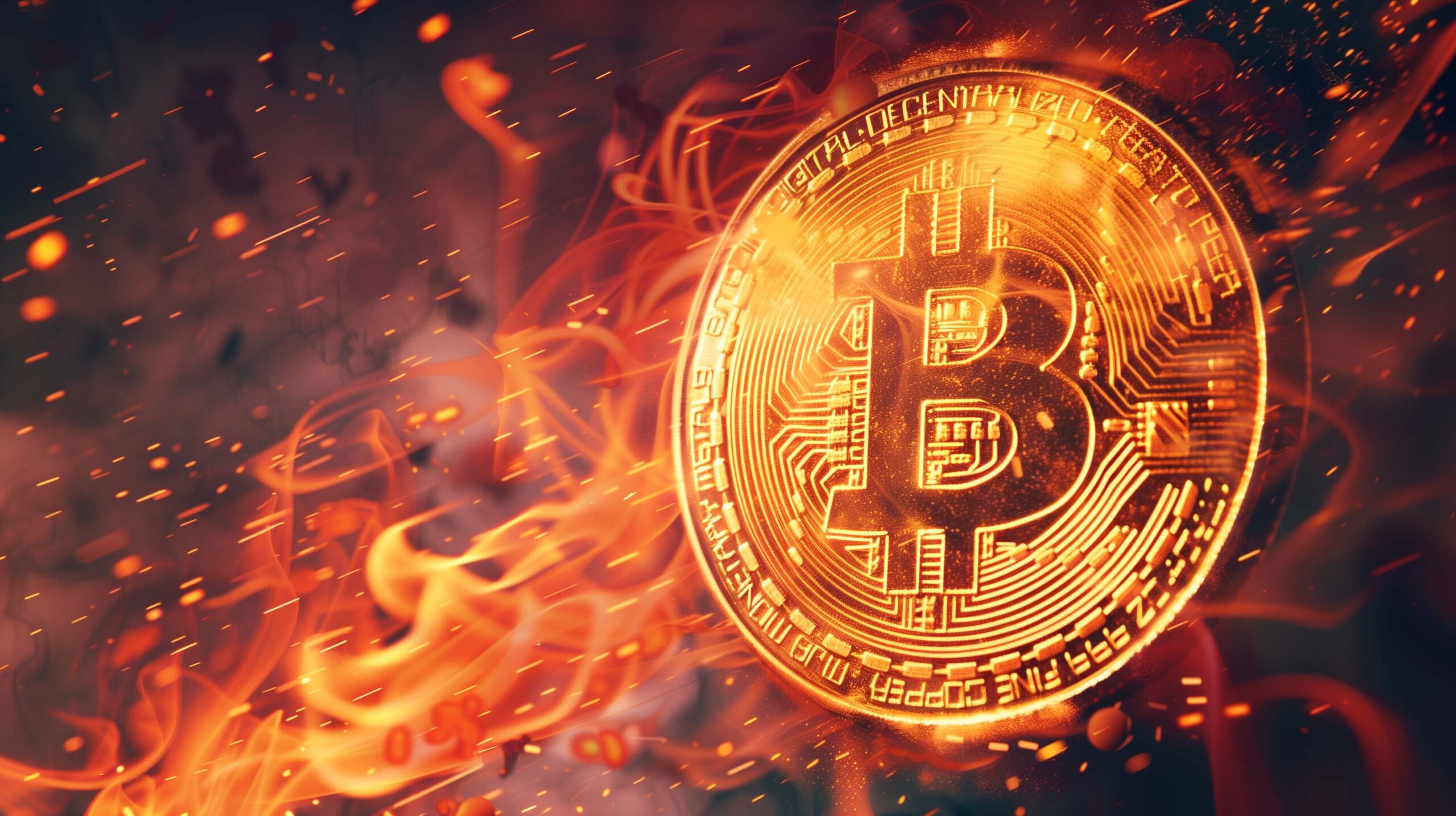
PayPal Launches Dollar-backed Stablecoin, PYUSD — What Crypto Merchants Need to Know
Aug 8, 2023
In an ambitious stride towards harnessing the power of blockchain, PayPal, a leading name in financial services, unveiled its latest digital endeavor: a stablecoin named PayPal USD or PYUSD.
This isn’t just any run-of-the-mill crypto announcement. It marks a significant milestone as PayPal becomes the first major American financial institution to launch its own stablecoin in a market brimming with potential.

The gist of PayPal’s stablecoin launch.
A Brief PYUSD Breakdown
Drawing from the core concept of stablecoins, PYUSD is designed to hold a steadfast value, pegged to the U.S. Dollar. This ensures that unlike the notorious price volatility seen in cryptocurrencies such as Bitcoin and Ethereum, PYUSD aims for stability.
As a payments giant with a legacy in revolutionizing digital transactions, PayPal’s foray into the world of stablecoins signals a new era for digital currencies.
Dan Schulman, the visionary CEO behind PayPal, emphasized the necessity of a digital instrument that’s innately digital yet easily tied to a fiat currency like the U.S. dollar. PYUSD isn’t just about trading. With the burgeoning world of web3 applications, online gaming, and the vast scope of international payments, PayPal envisions its stablecoin facilitating seamless and rapid transactions.
Regulators have long been cautious, with some global counterparts such as China taking stringent stances on crypto services. However, with a trusted name like PayPal championing the cause, it provides an impetus for a potential shift in regulatory perspectives.
As Bloomberg reported, while the crypto exchange terrain has seen its share of hurdles, from legal challenges with the SEC to debates on the nature of digital assets, PayPal’s association with Paxos Trust Company indicates a concerted effort to navigate these challenges.
In the vast landscape of wallets, treasuries, and digital assets, PYUSD stands as a testament to PayPal’s vision. It’s not just about adding another name to the list of dollar-backed stablecoins. It’s about shaping the future of digital transactions, where similar cash equivalents like Tether and Venmo have paved the way.
The Ins-and-Outs of Stablecoins
Stablecoins, as the name suggests, are digital currencies that aim to stabilize their value by pegging them to an external reference, most commonly the U.S. Dollar.
At their core, stablecoins exist to bridge the world of traditional fiat currency with the promise and potential of cryptocurrencies. The fusion of these two realms offers businesses and individuals the chance to harness the speed and decentralization of blockchain technology, while sidestepping the price volatility synonymous with cryptocurrencies such as Bitcoin and Ethereum.
Why Stablecoins Like PayPal USD Maintain a $1 Price Point
Central to understanding stablecoins is grasping why tokens like PayPal USD or PYUSD consistently hover around a $1 mark. This consistent value stems from the backing mechanisms in place. For each PayPal stablecoin in circulation, there are U.S. dollar deposits or similar cash equivalents held in reserve. This ensures that for every PYUSD token you own, there’s a U.S. Dollar backing it, creating a sense of trust and tangibility in the otherwise intangible world of crypto.
The Role of Stablecoins in Quick Crypto Trades
For crypto merchants and traders, the allure of stablecoins is evident. Given the unpredictable and often turbulent nature of crypto exchanges, having a digital asset like a dollar-backed stablecoin facilitates rapid and efficient trades. With PYUSD, users can fund purchases on Coinbase, Binance, or any other crypto exchange, providing an effective hedge against the unpredictability of pure cryptocurrencies.
Moreover, it acts as a smooth on-ramp and off-ramp between fiat and crypto, allowing users to checkout from their digital wallets and easily convert their assets back to traditional fiat currency.
Distinction between Stablecoins and Other Cryptocurrencies like Bitcoin and Ethereum
While all fall under the umbrella of digital currencies, stablecoins and other popular cryptocurrencies serve differing roles:
- Bitcoin: Often referred to as ‘digital gold’, Bitcoin was the pioneer, setting the stage for the crypto revolution. While it offers a decentralized system free from regulators, its value is subject to market dynamics, leading to its price volatility.
- Ethereum: Beyond just a cryptocurrency, Ethereum provides a platform for creating decentralized applications using smart contracts. While ETH, Ethereum’s native token, has its value, it’s also subject to market fluctuations.
- Stablecoins (e.g., PayPal USD, Tether): Their primary objective is stability. By anchoring their value to a fiat currency or other assets, they provide a safe harbor in the stormy seas of the crypto market, making them essential for trades, remittances, and as a store of value.
PayPal USD Is More About Trust than Features
In the volatile world of cryptocurrencies, PayPal USD (PYUSD) stands out as a beacon of stability. As a dollar-backed stablecoin, each PYUSD token is backed by one U.S. dollar deposit. This isn’t a mere claim; it’s an assurance.
Users can confidently approach the crypto exchange, knowing that their digital assets can be redeemed for U.S. dollar at any given moment, matching similar cash equivalents.
Backing Mechanisms
The strength of a stablecoin lies in its backing mechanism. PYPL’s venture into the stablecoin arena isn’t a half-hearted attempt. It’s a robust system that takes the trust factor seriously. The PayPal stablecoin relies on:
- U.S. dollar deposits, ensuring immediate liquidity.
- Short-term U.S. treasuries, which are considered among the safest assets.
- Other liquid assets that meet rigorous criteria to ensure the value doesn’t waver.
This three-pronged approach solidifies PayPal’s position in the crypto sphere, ensuring its users can trust their digital currency as they would any fiat currency.
PayPal and Paxos Trust Partnership
While PayPal’s name carries weight in the financial services sector, they’ve made a strategic move partnering with Paxos Trust Company, a New York-based regulated entity. Paxos is no stranger to the blockchain domain and brings a layer of credibility, especially when dealing with regulators and treasuries.
This partnership not only ensures PayPal’s compliance with American financial standards but also heralds a new era where traditional financial giants collaborate with blockchain innovators to reimagine digital currencies.
The Broader Impact of Blockchain and Cryptocurrency on Financial Services
While the world busies itself with trading bitcoin or Ethereum, Paxos envisions a transformative landscape where blockchain is the foundation of all financial services. It’s not just about facilitating crypto trades or holding wallets of digital assets. The ambition is larger; it’s about redefining the way we view fiat currency, fund purchases, and the very essence of how businesses and individuals transact.
Anticipating the Potential Hurdles and Breakthroughs in the Near Future
The path to this transformed financial landscape, paved with blockchain and cryptocurrencies, is fraught with challenges. Yet, with every hurdle comes a potential breakthrough:
- Payments Giant Revolution: Leading payments giants like PYPL are not just watching from the sidelines. With the recent PayPal launches, such as the PayPal USD stablecoin, these behemoths indicate a desire to lead rather than follow.
- Web3 and Beyond: Beyond the simple fund transfer or checkout processes, the emergence of web3 applications promises a world where every online interaction has a touch of blockchain. Be it online gaming or decentralized platforms, the financial services landscape is just at the brink of this revolution.
- Eyes on China and the East: While American financial institutions are making strides, the East, led by countries like China, is not far behind. Their approach to crypto, blockchain, and the integration with daily financial services is worth noting for any global observer.
Comparing PayPal’s Move with Other Financial Institutions’ Stances on Crypto
When Dan Schulman announced the company’s foray into the crypto space, the world took notice. Not just because of the brand’s stature, but due to the implications it holds for similar cash equivalents and financial institutions worldwide:
- Circle and Coinbase: Both have shown an avid interest in stablecoins, with Circle leading the way with its U.S. Dollar-backed offerings. Their approach, although distinct from PayPal’s, echoes the sentiment that stablecoins are not a fleeting trend but a mainstay in the financial lexicon.
- Venmo and Binance: Venmo’s user-friendly approach to crypto services and Binance’s vast crypto exchange network are two sides of the same coin. While Venmo demystifies crypto for the everyday user, Binance serves the dedicated crypto enthusiast. PayPal’s move finds a balance, aiming to serve both demographics with finesse.
- Tether’s Stance: As one of the earliest dollar-backed stablecoin players, Tether’s stance has always been clear. However, with PayPal and Paxos entering the arena, the dynamics might see a shift, signaling a matured and more regulated stablecoin market.
In essence, the financial services realm is at an inflection point. As blockchain and crypto intertwine deeper with traditional banking and payment mechanisms, a new dawn of financial interactions awaits. And in this evolving narrative, PayPal’s strategic moves will undoubtedly play a pivotal role.
How Crypto Merchants Can Prepare for the Future, With or Without PayPal
The dawn of the PYUSD era signifies a significant pivot in the digital currencies realm. PayPal, an undeniable payments giant, has not merely added another asset to the vast crypto market; it has orchestrated a powerful statement of intent.
With the introduction of the PayPal stablecoin, the company endorses the value proposition of stablecoins, signaling their long-term viability in the financial spectrum.
PayPal’s stablecoin stands poised to redefine online transactions. With PYUSD integrated into standard payment ecosystems, users can now effortlessly fund purchases, whether in fiat or crypto, heralding a new age in digital payments.
Imagine international transactions settled within minutes, not days, and without the hefty fees. This isn’t just about reducing transaction times or costs; it’s about reshaping the very essence of global commerce.
Soon, more brands may collaborate with financial entities, fostering a future where crypto is as ubiquitous as the American greenback.
In conclusion, as the landscapes of crypto and financial services converge, pivotal moves by industry stalwarts like PayPal are not merely strategic business decisions. They are harbingers of a transformative financial future, where blockchain, stablecoins, and traditional banking coalesce into a harmonious digital symphony. And in this unfolding narrative, PYUSD is but the opening note of a grand opus yet to be fully realized.




